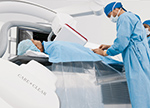New tube detector for angiography system
Studies show that on average one in four people suffer from atrial fibrillation, the most widespread form of cardiac arrhythmia, at some stage during their lives. Electrophysiological studies and interventions can be used to examine and treat a large number of patients. This involves ablating tiny points in the myocardial tissue using an ablation catheter in order to return the heart to its correct rhythm. Depending on the level of complexity, this type of procedure can take two to three hours. Each misrouting of the electrical impulses that trigger cardiac arrhythmia, which is measured in milliseconds, must first be located and mapped using electrophysiology catheters. It is only at that point that an individual treatment plan tailored to the patients’needs can be developed. This can now be achieved with radiation doses that are up to 85% below usual values, benefiting both patients and staff alike.
Another procedure where dose reduction is crucial is percutaneous coronary intervention (PCI), in which the cardiologist has to position a stent with millimeter precision despite cardiac movement. Using Artis Q.zen, the cardiologist is supported by the advanced guidance of Clearstent Live, which allows stent enhancement to take place in real time. The software eliminates cardiac movement, allowing cardiologists to verify stent positioning relative to the cardiac anatomy or to previously deployed stents. The enhanced images are displayed side-by-side with the current live-image without any noticeable lag while the operator can still move the balloon-mounted stent. The significantly better visualization of the stent and vessel section eliminates the need for additional images to decide whether the stent has been fully expanded.
The Artis Q.zen angiography system now comes with two new advances making it possible to reduce the radiation dose while maintaining and improving the quality


